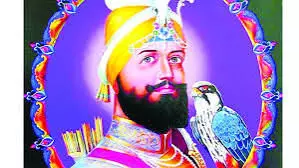KHALSA WAS A CONCEPT AHEAD OF ITS TIME

Baisakhi, a festival of harvest, is also a historical event wherein Guru Gobind Singh, the tenth Sikh Guru created the Khalsa, a psychological construct that galvanized common people to rise against oppression. To test their courage, the Guru with an unsheathed sword, called for volunteers to sacrifice themselves for the faith. The five brave hearts who stepped forward offering themselves for oblation, were initiated into the ‘Khalsa’, a name derived from Arabic word “Khalis” meaning pure.
These ‘Panj Pyare’ (five beloved ones), were not from Punjab alone. While Himmat Rai, a water-carrier, came from Jagannath Puri (Orissa), Mokham Chand, a tailor, belonged to Dwarka (Gujarat). Sahib Chand, a barber, hailed from Karnataka and Dharam Das, a farmer, was a native of Hastinapur (Delhi). Only Daya Ram, a shopkeeper, from Lahore represented Punjab. They were given a common surname of ‘Singh’, meaning Lion, and became the first members of this new order with a distinct identity, recognizable in a multitude.
While Khalsa is synonymous to a warrior ever ready for a righteous war, he also represents a tradition that unites the entire humanity breaking down discrimination of any sort. If this regional representation with different dialects signified the spirit of the oneness of “Akand Bharat”, the common surname further shed the caste distinction. ‘Manas ki jaat sabhe eke pehchanbo’, asserted the Guru, meaning that the whole human race was one. This resonated with the concept of “Vasudhaiva Kutumbakam”, a Sanskrit term, which refers to the whole world as one big family.
In the context of Mughal Empire, ‘Khalsa’ (pronounced Khalisah) also referred to the ‘crown land’. This land was directly owned by the emperor, without intermediaries like jagirdars or mansabdars, with the revenue generated going directly to the imperial treasury. Giving the title of Khalsa to commoners was a direct challenge to the ruling despot; his followers were no longer answerable to any emperor, instead, they, were now directly answerable to God.
Also, in those medieval times, the common man could connect with God only through intermediaries in a Pandit, Bhikkhu (monk) or Qazi. The languages used by these clerics in religious prayers were beyond the comprehension of the masses. Ipso facto these ‘messengers of God’ exploited the innocent and confused populace entangling them into incomprehensive rituals. Creation of the Khalsa also attempted to reduce these power-wielding clergy of all faiths into redundancy. The Sikhs were expected not to bow before any mortal; they would pay absolute obeisance only to their eternal Guru, ie Guru Granth Sahib.
Having completed his lifetime epitomic work, Guru Gobind Singh, proclaimed- “Khalsa mero roop hai khaas, Khalsey meh hau karau niwas” meaning Khalsa is my true form and within him I abide. It thus became his most precious resource for his fight for righteousness, equality and justice which eventually led to the emancipation of the oppressed lot that later rose to become rulers of their homeland. The Sikh invocation of ‘Raj Karega Khalsa, doesn’t mean rule by them; instead it alludes to a rule by those ‘pure ones’, directly linked with God, free from the scourge of ritualism, superstition and inequality.
